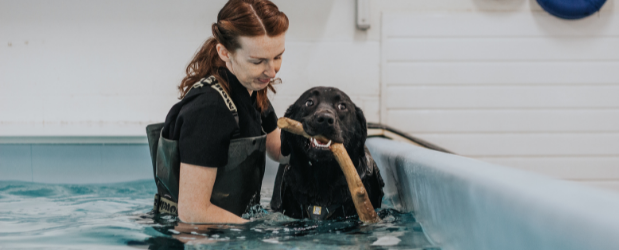
Small animal hydrotherapy is a branch of rehabilitation that can also provide a lightweight form of exercise for small animals. Hydrotherapy can be beneficial for domestic dogs and cats, or even wild breeds recovering from illness or injury. It can also help to relieve chronic conditions or provide low-impact exercise for older animals.
As the benefits of small animal hydrotherapy become widely understood by the public, the demand for trained and qualified animal hydrotherapists increases. So, for those seeking animal care roles, it is a good time to look into this type of animal rehabilitation.
Besides greater career opportunities available, working in this role can be a really enjoyable experience. You can have fun with animals that enjoy being in the water. But also feel rewarded as you help them return to good health.
It’s also a career that can often enable you to work flexible hours, depending on your client base. Plus, there’s growing scope for progression as the job market expands or you could open your own facility and train up to become and expert with a Level 6 qualification.
If this line of work interests you, you’ll be pleased to know you don’t have to leave your current job to go into full-time training. Courses in small animal hydrotherapy are now offered online. With a condensed element of practical training to practice what you’ve learnt.
Find out more about how you can study small animal hydrotherapy online below.

What you need to become a Small Animal Hydrotherapist
Before you start with training, you want to be sure being a small animal hydrotherapist is for you. You’ll absolutely need to be compassionate and comfortable with animals. But you’ll also need to be able to swim and handle physical work.
This is because you’ll be helping animals move through water and some will require more assistance than others. Which often means you need to stand, kneel and bend in awkward positions as you deliver techniques to the animals in your care.
The job also requires you to have an interest in animal anatomy and the science behind different treatments. As well as being able to communicate well with clients.
If you want to work as a small animal hydrotherapist then you should consider studying a qualification that enables you to get qualified and trained to handle animals in water. There are also complimentary animal care courses that can help with this type of career. Including, completing courses on canine/feline first aid, pool water management, hydrotherapy theory, canine anatomy, and physiology.
That’s why aspiring small animal hydrotherapists are more commonly taking courses specifically tailored to the profession. So, they have the skillset required and a full understanding of what’s expected of them in the role.
If you want to become a registered Canine Hydrotherapist in the UK, then you should look out for qualifications that enable you to become a member of the Canine Hydrotherapy Association (CHA) the National Association of Registered Canine Hydrotherapists (NARCH) or the Institute of Canine Hydrotherapists (ICH).

Studying Animal Hydrotherapy Online
Such a physical profession studied online may seem counter intuitive. However, there are numerous online courses that successfully prepare learners for this role. And many of these are regulated by Ofqual and other governing bodies to ensure your training meets rigorous standards.
For instance, the online Level 3 Diploma in Small Animal Hydrotherapy is Ofqual regulated and approved by the Canine Hydrotherapy Association (CHA).
In the course, you learn how to complete non or partially weight bearing exercises utilising the therapeutic properties of warm water. It takes you through modules that are key to the profession like gait analysis and biometrics, plus equipment maintenance. You’ll then complete assignments and submit a portfolio of evidence after each one.
You’re also assigned a dedicated tutor who reviews these submissions for you. That way, you’re provided with personalised grades and feedback that help you identify areas you may need to improve. Helping you stay on track with your learning and be as well prepared for the role as you can be.
What’s more, with no classes or deadlines you can work through the online element at your own pace. Enabling you to fit your learning around your current schedule and complete the course quickly if you have the capacity to.
This gives you a flexible blend of online learning and practical training. Which is far more realistic for students who have to juggle their education around existing jobs and family care commitments.

The online element of the courses
There’s no doubt being a small animal hydrotherapist is a hands-on job. Encouraging animals to perform exercises in water isn’t always easy, especially for those who aren’t a fan of swimming.
But a lot goes into learning about animals and the hydrotherapy process before you’re able to provide treatments. You need to understand the theoretical principles of animal hydrotherapy and treadmill therapy. As well as the academic guidance on the way these therapies can be used.
You need to be familiar with the range of conditions hydrotherapy treatments can benefit like orthopaedic, medical and neurological issues. Not to mention first aid procedures and how to handle small animal emergencies.
These courses also teach you about small animal behaviours in a therapeutic setting. Along with methods for assessing treatment outcomes and whether hydrotherapy treatment is suitable for specific cases.
You’ll also explore small animal anatomy and biology in detail. As well as the basic requirements of administering hydrotherapy. Which includes assessing and handling animal clients, operating equipment, and other fundamental aspects for effective treatment.
The online element finishes with training on the organisation of aftercare and how to communicate the outcome with animal guardians. Including paperwork requirements like reporting on hydrotherapy treatments.

Your hands-on training
You’ll get the chance to put your learning into practice in 6 days of hands-on training. This can be undertaken at various times throughout the year. So, it’s easier for you to complete at a time that suits you.
Blending online theory with practical training is crucial to make sure you can effectively support small animals in treatment. Which is why you are required to train alongside a team of qualified and experienced vets, animal physiotherapists and animal hydrotherapists.
You’ll apply your knowledge in real-life scenarios as you work with animals receiving rehabilitation and conditioning treatments. Becoming familiar with essential equipment like underwater treadmills, pools and hydrotherapy spas. And practising various techniques like pool hydrotherapy and advanced aquatic treadmill techniques.
All of which helps you gain real life experience of the industry and diverse cases in different stages of treatment.

Online courses like the Level 3 Diploma in Small Animal Hydrotherapy enable you to requalify with minimal disruption to your life. You can continue to earn and keep to your existing responsibilities while preparing for a fulfilling role in animal rehabilitation.
With flexible learning and increasing demand for professionals, now is the perfect time to train as a small animal hydrotherapist. And you can do so confidently with Stonebridge Associated Colleges.
As the UK’s leading online learning provider, our courses will equip you with essential industry knowledge and skills.
Find out more about getting started by viewing the course specification below.






















Leave a Reply